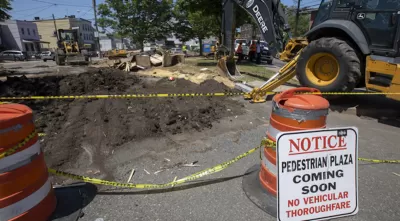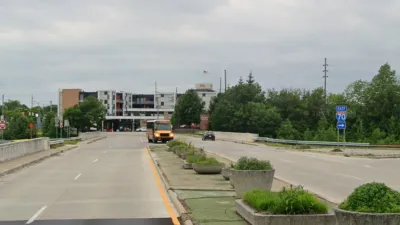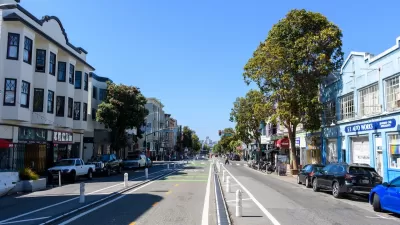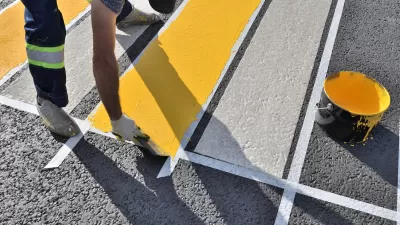The city’s new Department of Infrastructure consolidates the management of public amenities and has guided the creation of new bike lanes, pedestrian plazas, and parks.

The decision to consolidate the management of streets, transit, parks, municipal buildings, and other public facilities into one Department of Infrastructure in Jersey City, New Jersey has made a significant impact on the city’s public realm, writes Robert Steuteville in Public Square.
The consolidation has helped the city understand its transportation and mobility needs and resources from a broader perspective. “The department and policies leading up to its creation were pivotal in implementing nearly 25 miles of protected bike lanes, carving pedestrian plazas from excess asphalt, planting more than 1,000 trees, building new parks, renovating public spaces, and creating parklets for outdoor dining.”
The rapid changes are also due to the city’s embrace of tactical urbanism strategies — quick-build, low-cost interventions usually implemented by local activists that skirt traditional bureaucratic processes. In the case of Jersey City, the city itself adopted the concept to deploy nimble, low-cost projects that have led to permanent changes. “Leftover tennis court paint and planters were used to build a pedestrian plaza through the heart of the downtown dating from the 17th Century. Road diets were implemented along major streets to establish the protected bike lane network using paint and vertical separation. The nimble fleet of micro-transit vans was employed to fill gaps in transit access.” In 2022, the city eliminated traffic deaths for a full year on city-managed roads thanks in large part to quick-build road safety interventions.
For Steuteville, Jersey City is a prime example of what can happen when a city takes a holistic view of infrastructure and rejects bureaucracy in favor of immediate — and sometimes life-saving — improvements to the public realm.
FULL STORY: Infrastructure Department boosts the public realm

Maui's Vacation Rental Debate Turns Ugly
Verbal attacks, misinformation campaigns and fistfights plague a high-stakes debate to convert thousands of vacation rentals into long-term housing.

Planetizen Federal Action Tracker
A weekly monitor of how Trump’s orders and actions are impacting planners and planning in America.

In Urban Planning, AI Prompting Could be the New Design Thinking
Creativity has long been key to great urban design. What if we see AI as our new creative partner?

King County Supportive Housing Program Offers Hope for Unhoused Residents
The county is taking a ‘Housing First’ approach that prioritizes getting people into housing, then offering wraparound supportive services.

Researchers Use AI to Get Clearer Picture of US Housing
Analysts are using artificial intelligence to supercharge their research by allowing them to comb through data faster. Though these AI tools can be error prone, they save time and housing researchers are optimistic about the future.

Making Shared Micromobility More Inclusive
Cities and shared mobility system operators can do more to include people with disabilities in planning and operations, per a new report.
Urban Design for Planners 1: Software Tools
This six-course series explores essential urban design concepts using open source software and equips planners with the tools they need to participate fully in the urban design process.
Planning for Universal Design
Learn the tools for implementing Universal Design in planning regulations.
planning NEXT
Appalachian Highlands Housing Partners
Gallatin County Department of Planning & Community Development
Mpact (founded as Rail~Volution)
City of Camden Redevelopment Agency
City of Astoria
City of Portland
City of Laramie





























